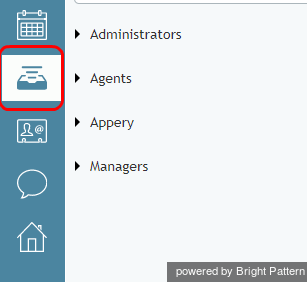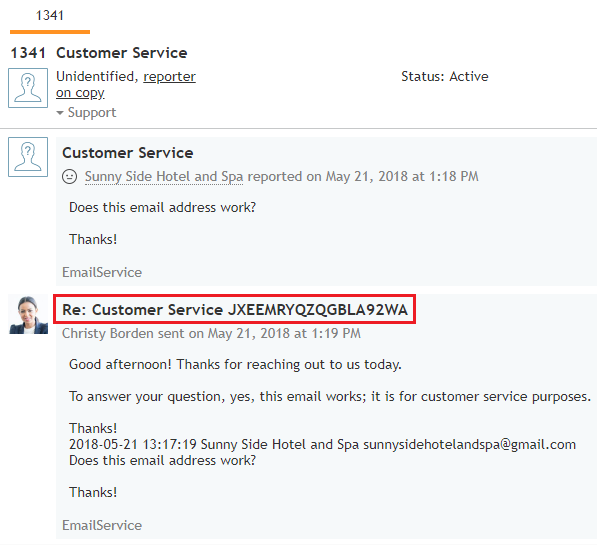(Created page with "<translate>= Cases, Email, and Threads = All emails are cases but not all cases are emails. Every email interaction is associated with a ''case'' and can be part of a ''threa...") |
|||
| Line 1: | Line 1: | ||
<translate>= Cases, Email, and Threads = | <translate>= Cases, Email, and Threads = | ||
| − | + | In Agent Desktop, [[Agent-guide/WhatIsAgentDesktop|interactions]] can be associated with a ''case'', be an ''email'', and can be part of a ''thread''. But what is the difference between these things? In this article, we explain the difference between cases, email, and threads. | |
| − | + | == Cases and Email == | |
| + | A case is an instance of customer service that is created to track all communications related to a specific customer request. Cases can be [[Agent-guide/HowtoCreateNewCases|created manually]] in your contact center or automatically if they arrive there as email. By contrast, email is a specific channel customers use to interact with your contact center. | ||
| − | + | Email is a type of interaction you can receive at your contact center that are automatically assigned case numbers. In short, all emails are cases but not all cases are emails. | |
| − | |||
| − | |||
| + | In both instances, the system automatically assigns a number to the case/email that is unique within your contact center (e.g., ''14355''); it is maintained as an active entity while the request is being worked on, and closed when the request is fulfilled. | ||
| − | + | This number is typically communicated to the customer and can be used by both the customer and yourself to refer to the given request in all future communications. This number also helps you quickly find all past communications related to the case in the email history. | |
| − | |||
A case is closed when you assign a final [[agent-guide/HowtoEnterDispositionsandNotes|disposition]] to an email associated with this case. A final disposition is a disposition that indicates that no further follow-up is expected or necessary for the given case (e.g., the customer has confirmed request fulfillment). Dispositions are fully customizable and can often be service-specific. Your system administrator will explain how to use dispositions and point out the ones that can be used to close cases. | A case is closed when you assign a final [[agent-guide/HowtoEnterDispositionsandNotes|disposition]] to an email associated with this case. A final disposition is a disposition that indicates that no further follow-up is expected or necessary for the given case (e.g., the customer has confirmed request fulfillment). Dispositions are fully customizable and can often be service-specific. Your system administrator will explain how to use dispositions and point out the ones that can be used to close cases. | ||
| Line 18: | Line 17: | ||
[[File:Email-Cases-50.png|450px|thumbnail|center|My Cases]] | [[File:Email-Cases-50.png|450px|thumbnail|center|My Cases]] | ||
| − | |||
| − | |||
| − | |||
== Threads == | == Threads == | ||
A group of emails related to the same case is called an ''email thread''. Threads are created when the system matches in-reply-to email headers. Additionally, when you reply to a customer’s request for the first time, the system will generate a unique thread identifier and attach it to the email subject. Unlike the case number, the email thread identifier may contain both numbers and letters (e.g., ''JXA6PDRNQ2SO'') and is intended primarily for automatic processing. | A group of emails related to the same case is called an ''email thread''. Threads are created when the system matches in-reply-to email headers. Additionally, when you reply to a customer’s request for the first time, the system will generate a unique thread identifier and attach it to the email subject. Unlike the case number, the email thread identifier may contain both numbers and letters (e.g., ''JXA6PDRNQ2SO'') and is intended primarily for automatic processing. | ||
| − | |||
For example, when a new email comes in, the system will analyze the subject to see if there is a matching email header. If a matching header is found and recognized, the system will automatically assign that email to the corresponding case. Depending on your service configuration, the system may also attempt to deliver that email to you if you have previously worked on this case. | For example, when a new email comes in, the system will analyze the subject to see if there is a matching email header. If a matching header is found and recognized, the system will automatically assign that email to the corresponding case. Depending on your service configuration, the system may also attempt to deliver that email to you if you have previously worked on this case. | ||
Revision as of 23:58, 4 February 2019
<translate>= Cases, Email, and Threads = In Agent Desktop, interactions can be associated with a case, be an email, and can be part of a thread. But what is the difference between these things? In this article, we explain the difference between cases, email, and threads.
Cases and Email
A case is an instance of customer service that is created to track all communications related to a specific customer request. Cases can be created manually in your contact center or automatically if they arrive there as email. By contrast, email is a specific channel customers use to interact with your contact center.
Email is a type of interaction you can receive at your contact center that are automatically assigned case numbers. In short, all emails are cases but not all cases are emails.
In both instances, the system automatically assigns a number to the case/email that is unique within your contact center (e.g., 14355); it is maintained as an active entity while the request is being worked on, and closed when the request is fulfilled.
This number is typically communicated to the customer and can be used by both the customer and yourself to refer to the given request in all future communications. This number also helps you quickly find all past communications related to the case in the email history.
A case is closed when you assign a final disposition to an email associated with this case. A final disposition is a disposition that indicates that no further follow-up is expected or necessary for the given case (e.g., the customer has confirmed request fulfillment). Dispositions are fully customizable and can often be service-specific. Your system administrator will explain how to use dispositions and point out the ones that can be used to close cases.
Threads
A group of emails related to the same case is called an email thread. Threads are created when the system matches in-reply-to email headers. Additionally, when you reply to a customer’s request for the first time, the system will generate a unique thread identifier and attach it to the email subject. Unlike the case number, the email thread identifier may contain both numbers and letters (e.g., JXA6PDRNQ2SO) and is intended primarily for automatic processing.
For example, when a new email comes in, the system will analyze the subject to see if there is a matching email header. If a matching header is found and recognized, the system will automatically assign that email to the corresponding case. Depending on your service configuration, the system may also attempt to deliver that email to you if you have previously worked on this case.
</translate>


